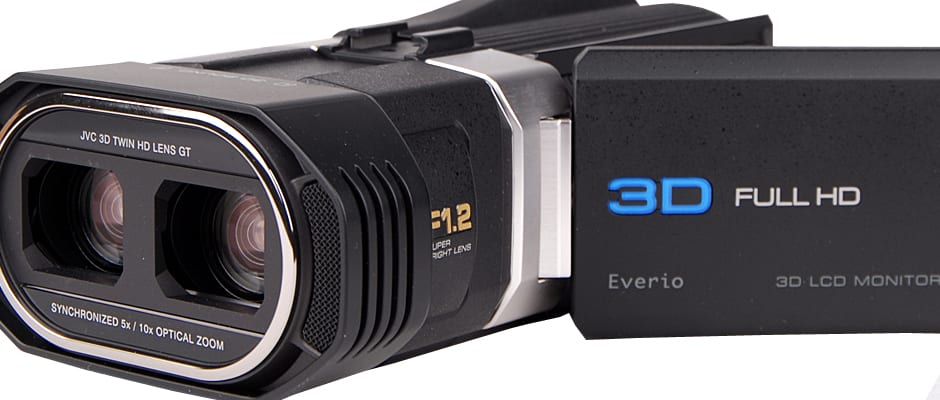Pros
Cons
Introduction
JVC recently announced a price cut for the TD1, which is now listed as $1699 on the web (it was $1999 upon initial release). It's not cheap, but if you're a 3D video enthusiast the GS-TD1 is one of the few options available.
Front
{{section_header}}{{section.name}}{{/section_header}}

Back
{{section_header}}{{section.name}}{{/section_header}}

Left
{{section_header}}{{section.name}}{{/section_header}}
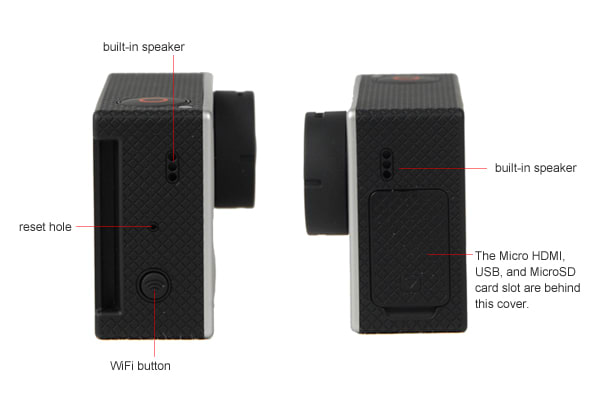
Right
{{section_header}}{{section.name}}{{/section_header}}
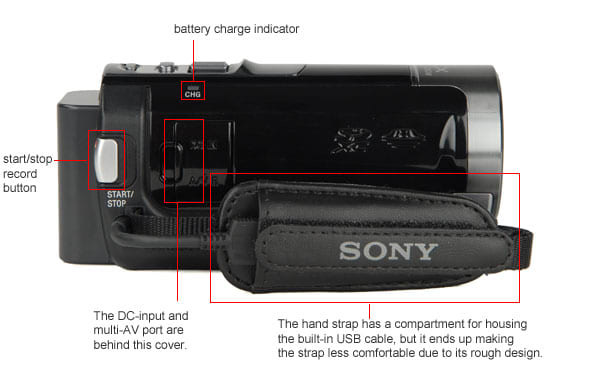
Top
{{section_header}}{{section.name}}{{/section_header}}

Bottom
{{section_header}}{{section.name}}{{/section_header}}

In the Box
{{section_header}}{{section.name}}{{/section_header}}

The JVC Everio GS-TD1 comes with:
- rechargeable battery pack with charging adapter
- HDMI cable
- AV cable
- USB cable
- remote control
- instruction manual
- software CD
Color
{{section_header}}{{section.name}}{{/section_header}}
The JVC GS-TD1's numbers in our color accuracy test were average at best, as the camcorder managed a color error of 4.8 and a saturation level of 92.29% in bright light. What surprises us most about these results is the fact that JVC once dominated this test just a few years ago (particularly with its mid-range models). JVC must have tweaked something on its new camcorders that made them render colors with less accuracy. At least the saturation level is still good, though. More on how we test color.
Color Accuracy Performance
Color Error Map The map above is a diagram of the color error. The length and direction of each line indicates how the camera processed each particular color while capturing video.
The JVC GS-TD1 produced a color error of 4.80 and a saturation level of 92.29% in our bright light color testing.
Unlike most flagship models, the JVC GS-TD1 has no color presets or color controls. Not one. This is unfortunate because determining color quality is a truly subjective practice. Some people may want things more vivid, others more cool, others less saturated overall. Since the TD1 doesn't allow you to make any of these adjustments, you're essentially stuck with what you get from auto mode.
The TD1 has a bright image that can appear somewhat washed out along side camcorders that produce colorful images with more contrast. Check out the test images from the Panasonic HDC-SDT750 and Canon HF G10 below, both of which produced slightly darker video in our bright light tests. This darkness gives the colors more pop compared to what the GS-TD1 produced, but the difference is slight—and the color performance you prefer is entirely based on personal preference.
{{comparison_bars title="Color Score Comparison", attribute="Color Score", xLabel="Color Score"}}
Low Light Color
{{section_header}}{{section.name}}{{/section_header}}
Usually, we see a dip in color accuracy when we test camcorders in low light, but the JVC GS-TD1 actually did better in our color accuracy test in low light than it did in bright light. The difference wasn't huge, but the TD1 managed a color error of 4.57 in our low light test (compared to 4.8 in bright light). The camcorder's color saturation did go down in low light however, with the camcorder registering a saturation level of 84.71%. More on how we test low light color.
Low Light Color Accuracy Performance
Color Error Map The map on the left is a diagram of the color error. The length and direction of each line indicates how the camera processed each particular color while capturing video.
The JVC GS-TD1 produced a color error of and a saturation level of in our bright light color testing.
While the GS-TD1's color scores in bright light weren't great, its low light scores were not bad for a camcorder of its class. In particular, its saturation level was higher than what we saw from the competition. Best of all, the TD1's results are a whole lot better than what we saw from the JVC GZ-HM1 last year in this test.
Noise
{{section_header}}{{section.name}}{{/section_header}}
Like we saw in our color test, the GS-TD1 also put up pedestrian numbers in our second bright light test: noise. On average, the TD1 measured 0.76% noise in bright light—a percentage that is double what the Panasonic HDC-SDT750 3D camcorder measured in this same test and higher than what the Canon HF G10 and JVC GZ-HM1 produced as well. More on how we test noise.
As you can see from the crops above, the GS-TD1 produced an extra sharp image in our bright light testing. In fact, it managed to capture some of the sharpest HD video we've seen from a consumer camcorder (just like the JVC GZ-HM1 did last year). The 60p mode on the HDC-SDT750 and other models from Panasonic also captured very sharp video, but the GS-TD1 is right up there as well. Take a look at the comparison images and see for yourself!
Just to note: the TD1 also had very good sharpness in 3D recording, but only when we used the higher-quality "Double Full HD" record modes that use MPEG-4 compression. The 3D AVCHD modes did not produce very sharp images, however, and you can read more about this on the next page of our review.
{{comparison_bars title="Noise Score Comparison", attribute="Noise Score", xLabel="Noise Score"}}
Low Light Sensitivity
{{section_header}}{{section.name}}{{/section_header}}
Last year, JVC improved the low light sensitivity on its high-end camcorders. This improvement didn't continue with the GS-TD1, as the camcorder needed 20 lux of light to reach 50 IRE on our waveform monitor. Let's be clear, this performance is not great for a high-end camcorder, but it isn't as bad as the results we've seen from some other flagship models (like the Sony HDR-CX700V).
The best news is the GS-TD1 showed no loss in low light sensitivity when we switched over to 3D recording. This stands in stark contrast to the Panasonic HDC-SDT750, which required 450% more light to record a usable image with its 3D conversion lens attached. The GS-TD1's twin sensor/lens combination makes it so you don't need that extra light when recording 3D—the same amount of light needed for 2D recording is all that is required. More on how we test low light sensitivity.
Since the GS-TD1 has a wide angle lens, we also tested the camcorder's low light sensitivity without using any optical zoom and the aperture set to its widest f/1.2. This resulted in the camcorder needing just 8 lux of light to reach 50 IRE on our waveform monitor—a score that is far better, but is still below average for a high-end model. With the GS-TD1's very wide aperture of f/1.2 we expected the camcorder to do better here. In comparison, the Canon HF G10 needed just 3 lux of light when we were fully zoomed out with the camcorder (and it has an f/1.8 lens).
{{comparison_bars title="Low Light Sensitivity Comparison", attribute="Low Light Sensitivity Score", xLabel="Low Light Sensitivity Score"}}
Low Light Noise
{{section_header}}{{section.name}}{{/section_header}}
Noise results were solid from the GS-TD1 in our low light test. The camcorder averaged just over 1.0% noise in this test, which is better-than-average for a high-end camcorder. The Panasonic HDC-SDT750 and Canon HF G10 did have less noise in their low light images, but not by huge amounts. More on how we test low light noise.
The TD1's low light image was a bit blurry and murky, as you can see from the crops above. This is in-line with what we saw from the JVC GZ-HM1 last year, although that camcorder had more artifacting and fine noise than the GS-TD1. You can see how the TD1 stacked up against other models by cycling through the crops above.
{{comparison_bars title="Low Light Noise Score Comparison", attribute="Low Light Noise Score", xLabel="Low Light Noise Score"}}
Low Light Color
{{section_header}}{{section.name}}{{/section_header}}
Usually, we see a dip in color accuracy when we test camcorders in low light, but the JVC GS-TD1 actually did better in our color accuracy test in low light than it did in bright light. The difference wasn't huge, but the TD1 managed a color error of 4.57 in our low light test (compared to 4.8 in bright light). The camcorder's color saturation did go down in low light however, with the camcorder registering a saturation level of 84.71%. More on how we test low light color.
Low Light Color Accuracy Performance
Color Error Map The map on the left is a diagram of the color error. The length and direction of each line indicates how the camera processed each particular color while capturing video.
The JVC GS-TD1 produced a color error of and a saturation level of in our bright light color testing.
While the GS-TD1's color scores in bright light weren't great, its low light scores were not bad for a camcorder of its class. In particular, its saturation level was higher than what we saw from the competition. Best of all, the TD1's results are a whole lot better than what we saw from the JVC GZ-HM1 last year in this test.
Motion
{{section_header}}{{section.name}}{{/section_header}}
Like the GZ-HM1 before it, the GS-TD1 did a fantastic job in our motion test. 2D footage looked smooth, with minor amounts of artifacting, and very little interference. Essentially, the TD1 produced some of the best motion video we’ve ever seen, and it did all this without using a 60p record mode (it records all video at 60i). The camcorder does output video with an upconverted 60p signal when you watch content on a compatible HDTV via an HDMI connection, however, so this may be a reason our motion test videos looked so good.
3D footage on the camcorder had its share of problems. There was plenty of blur and trailing, but we see that all the time when watching 3D content (even with professional 3D movies!). When using the AVCHD 3D record modes there was a lot more artifacting present in our motion test, but much of this artifacting disappeared when we switched to the higher-quality MPEG-4 3D record modes. In all, we liked the 3D motion performance better on the GS-TD1 than we did on the Panasonic HDC-SDT750.
Would you like to see for yourself how the GS-TD1’s 3D video looks? Just check out the video above that we uploaded to YouTube. Keep in mind, YouTube is still figuring out all the kinks associated with 3D content, so the video below will look nothing like 3D footage you shoot with the TD1 and then view on a 3D HDTV. You’ll also need 3D glasses to view the video below in 3D—just like you would if you watched footage on a 3D television. We have the video set to work with red/cyan 3D glasses, but you can change the kind of glasses you need by clicking on the "3D" button in the YouTube window.
Video Sharpness
{{section_header}}{{section.name}}{{/section_header}}
The GS-TD1 produced some top-notch results in our video sharpness test. In 2D record mode, the TD1 managed a horizontal sharpness of 1000 lw/ph and a vertical sharpness of 650 lw/ph. These are the same results that last year's JVC GZ-HM1 registered (and they are very good scores). These are the best numbers we've seen from a camcorder that uses 60i recording instead of a 60p frame rate.
We were also able to obtain data for 3D recording in this test and the results were very positive, but we did notice significant differences depending on what 3D mode used. The better sharpness scores came from when we recorded using the original format MPEG-4 3D mode (the "Double Full HD" option). Shooting with that mode, in the highest-quality THR setting, we saw sharpness levels of around 900 lw/ph horizontal and 600 lw/ph vertical. This impressed us quite a bit, as the camcorder produced a far sharper image than the Panasonic HDC-SDT750 was capable of when recording 3D video. We were also surprised that the sharpness was nearly that of the TD1's results in our 2D testing.
Recording 3D content using the AVCHD modes resulted in far worse sharpness scores. The TD1 measured a horizontal sharpness of 575 lw/ph and a vertical sharpness of 600 lw/ph. These numbers aren't terrible, though, and they are roughly in-line with what we see from mid-range or entry-level HD camcorders. All these numbers prove that the "Double Full HD" 3D modes that JVC raves about on the GS-TD1 are certainly better when it comes to sharpness. The higher bitrates and dual 1920 x 1080 images make a strong difference. More on how we test video sharpness.
{{comparison_bars title="Video Sharpness Score Comparison", attribute="Video Sharpness Score", xLabel="Video Sharpness Score"}}
Ease of Use
{{section_header}}{{section.name}}{{/section_header}}
With its big body and dual lens system, the GS-TD1 can look like a daunting camcorder. Its size does make it more difficult to wield than your average consumer camcorder, but it isn't all that much more difficult. Maybe your hand will tire sooner, or maybe you'll have to use a second hand to stabilize the camcorder, but neither of these things really make the TD1 that much more difficult to figure out. The menu system is equipped with a help feature that is supposed to give you tips and information about menu options. The problem is, the help feature doesn't always work. At times, there were menu options we wanted to find more info about, and a message would pop up saying "help not available." We like the feature, but JVC needs to fix this problem.
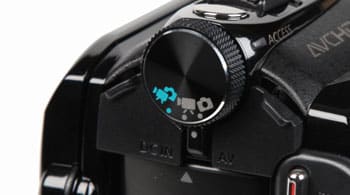
Auto Mode is confusingly called Dual Shot mode
What JVC gets right on the GS-TD1 is 3D recording. You don't have to attach, calibrate, or set any controls on the lens in order to shoot 3D video with the TD1—something that stands in stark contrast to the Panasonic 3D camcorder. All you have to do to record 3D video with the GS-TD1 is turn on the camcorder, press the 3D button on the back, and you're all set. The camcorder sets everything else automatically, which is a great advantage for anyone who is afraid of performing a lens calibration or adjusting the parallax between the two lenses. The fact that you can use zoom and other manual controls in 3D mode also makes the TD1 easier to use, as it gives the videographer more flexibility if they want it.
Auto Mode
{{section_header}}{{section.name}}{{/section_header}}
The automatic controls on the GS-TD1, in both 2D and 3D record modes, were a pleasant surprise. Autofocus and auto exposure both produced smooth, gradual transitions when we used the camcorder, which we liked quite a bit. The auto white balance was also surprisingly good, as we've seen a few high-end models recently that did not do well with auto white balance. All of these auto controls can be used in manual mode, or you can set the camcorder to function entirely on automatic controls in its Intelligent Auto mode (iA).
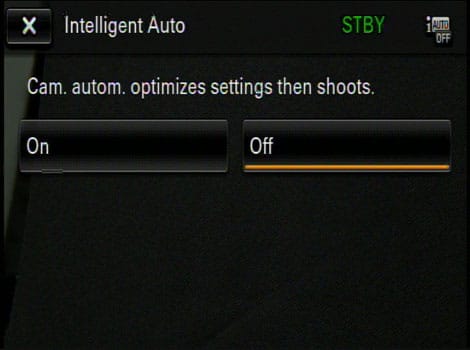
The iAuto mode button is difficult to find, but when you do find it the option for turning on the mode looks like this.
Auto Controls
{{section_header}}{{section.name}}{{/section_header}}
If you don't like the automatic transitions of focus and exposure, you can use the new AF/AE Touch feature on the GS-TD1. Touch and tracking features like this have appeared on most high-end models from other manufacturers, but JVC was late to adopt this option because of its previous use of the Laser Touch Strip control rather than a full-fledged touchscreen. The TD1 has a touchscreen, however, so the camcorder makes good use of its new abilities. The tracking feature works with face detection by following a face as it moves around the frame (and focuses and exposes accordingly), or you can set it to track a specific color. This color tracking feature is interesting, but we also found it to be less useful than face tracking. If two similar colors appear in the frame, the camcorder can get confused.
You can also use a "touch focus" feature that is part of the new tracking system. This allows you to tap a part of the screen and that area will be focused and exposed properly (Sony has this same feature on its camcorders). Just like regular autofocus and auto exposure, the system works fairly gradually, which is great for people who like those smooth focus transitions. The GS-TD1 also has plenty of scene modes and a backlight compensation option.
Handling
{{section_header}}{{section.name}}{{/section_header}}
The GS-TD1 is a large camcorder, there's no getting around that fact, but JVC tried very hard to make it comfortable to hold despite its girth. The right side is outfitted with a large, thick hand strap that is more comfortable than JVC's usual fare. Unfortunately, even an excellent hand strap can't make up for the fact that the TD1 is very thick. It is difficult to wrap your fingers around the wide top of the camcorder, and there is little in the way of grooves for gripping. The ribbed surface on the top of the camcorder isn't bad for resting your fingertips, but we'd like more to grip onto.

The size of the GS-TD1 isn't our biggest issue with the camcorder in terms of handling. Yeah, it's big, but that's something you just need to deal with—it is a 3D camcorder with two lenses, after all. No, our biggest problem is the sluggish performance of the TD1's menu interface. Whenever we tried to adjust controls or access menu options during recording we ran into serious problems. Menus took a few seconds to load, controls were impossible to adjust precisely, buttons simply didn't respond. Things were fairly slow even when we tried to access them before we started recording (particularly when the camcorder was in 3D mode), but the worst of it was while recording was taking place.

The fact that the adjustment dial on the back of the camcorder is poorly designed made this interface problem even more of an issue. If you're going to include a dial for controls on a camcorder, why not make it a good one? The small, plastic dial on the TD1 simply doesn't cut it, and we wish there was a larger, metal dial like you see on high-end models from Sony and Canon (or a lens ring like Panasonic offers).

The touchscreen interface on the LCD monitor itself isn't bad, and we like the fact that the screen is 3.5-inches in size, but we can't get over how bad everything looks when the screen is set to its "glasses free 3D mode." Everything on the screen appears blurred in this mode, and, while there is a subtle 3D effect, it looks nothing like your 3D footage will appear on a large 3D television. We couldn't stand looking at the LCD in its 3D mode for more than a few seconds before it made us slightly dizzy and we had to shut it off. Luckily, everything looks crisp and pleasant on the LCD in 2D mode (and thank god there's an option for switching between the two).

These dedicated buttons give you quick access to aperture and shutter speed controls.
Portability
{{section_header}}{{section.name}}{{/section_header}}
The TD1 weighs a hefty 675g (1.43 pounds) with its provided battery pack installed. This makes for quite a heavy camcorder, although anyone who is used to the old tape-based models from the 80's and 90's shouldn't find the weight of the TD1 to be any kind of problem. Still, compared to modern camcorders, the GS-TD1 is a heavy model. It is a good 85g heavier than the largest 2D camcorder we've reviewed this year, the Canon HF G10 (590g).
The Panasonic HDC-SDT750, with its 3D lens attached, isn't much lighter than the TD1. It weighs in at 630g fully loaded, and that's with the 3D lens adding close to 200g to the total weight. The thing is, you can take this conversion lens off to record 2D video, thus turning the SDT750 into a far lighter and more compact camcorder (something you can't do with the TD1).
The point is, if you want a compact camcorder, the GS-TD1 is not a good fit for you. But, if you're looking to record high-quality 3D video, there isn't anything out there that we'd consider to be "light", and JVC did a decent job at keeping the TD1 a manageable size. It's large and heavy, but it's not crazy.
Battery Life
{{section_header}}{{section.name}}{{/section_header}}
We tested the GS-TD1's battery life in 3D record mode and 2D record mode, and both were excellent. The camcorder lasted for 175 minutes of straight recording with its provided battery pack in 2D video mode. This is even longer than the 167-minute performance we saw from the Everio GZ-HM1 last year. What really surprised us, however, was that the GS-TD1 still managed a top-notch battery life of over 2 hours when we recorded in 3D video mode (124 minutes, to be exact). Yes, it's a shorter battery life than 3D mode, but it is still longer than most high-end camcorders last in this test. It is time we give JVC more credit for the longevity of its battery packs! More on how we test battery life.
Setting the good battery life performance aside, we must admit we're not fans of the GS-TD1's battery compartment. The compartment is located on the right side of the camcorder, which means the door flips open in an area where the large hand strap can be in the way. You must insert the battery into a large, hollow compartment that is essentially the center of the camcorder. It's hard to get your fingers in there to make sure the battery has a proper fit, particularly if you don't have small hands. Let's just say this design is more difficult to access than a simple rear-mounted battery compartment like you see on most camcorders.

{{comparison_bars title="Battery Life Comparison", attribute="Battery Life Score", xLabel="minutes"}}
LCD
{{section_header}}{{section.name}}{{/section_header}}
The LCD on the GS-TD1 comes with a twist. Not only does it have a 3.5-inch touchscreen, but it also has a "glasses-free" 3D view mode. Yes, you can watch 3D video right on the camcorder itself, or you can switch to this mode and use it during 3D recording to better frame your shot. But hold on a second, does this 3D mode really enable you to see 3D images without the aid of special glasses? The truth is, not really. The mode produces a 3D effect on the LCD, but the images look blurry and will probably give you a headache if you look at it too long. And the resultant video will look entirely different on the LCD than it will on a big, 3D television that requires the use of 3D glasses. Basically, the LCD gives you a simplified, gimmicky 3D view mode that is in no way similar to the look of a 3D HDTV. In regular 2D view mode, the LCD looks pristine and beautiful. In fact, our favorite feature about the LCD's 3D mode is that you can turn it off and switch to regular 2D view whenever you want.
The GS-TD1 does not come with a viewfinder—not even for 2D-view only.
Stabilization
{{section_header}}{{section.name}}{{/section_header}}
The JVC GS-TD1 has two image stabilization systems, both of which appear to use digital stabilization technology (which can result in a degradation of image quality). The regular stabilization mode is called DIS in the TD1's menu, and the advanced setting is called AIS.
We tested the regular DIS on the camcorder and we found it to be of average effectiveness. In our low shake test, the DIS setting enabled the camcorder to reduce 35% of the shake. Things weren't much different in our high shake test—the DIS setting reduced 31% of the shake. More on how we test stabilization.
Both of these shake reductions are good, but they aren't great. Many high-end camcorders do much better in this test, and the fact that the GS-TD1 is outfitted with a digital stabilization system rather than an optical one is somewhat disconcerting. Optical stabilization does not reduce image quality, while digital systems definitely can (but usually by not very much). The stabilization feature on the TD1 works in all record modes—including 3D settings.
Manual Focus
{{section_header}}{{section.name}}{{/section_header}}
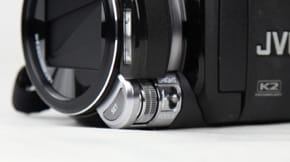
The adjustment dial makes accurate focus adjustments easy.
Miscellaneous Controls
{{section_header}}{{section.name}}{{/section_header}}
Tele Macro
Tele Macro allows you to bring close up images into focus that the camcorder would normally not be able to focus on.
Grid
Displays a 9-sector grid on the LCD to assist with framing. The grid won't end up in your recorded footage since it is for framing purposes only.
x.v. Color
Lets the camcorder record video using the xvYCC expanded color gamut. You'll only see a difference if you view the footage on an xvYCC compatible television, however.
Auto Controls
{{section_header}}{{section.name}}{{/section_header}}
If you don't like the automatic transitions of focus and exposure, you can use the new AF/AE Touch feature on the GS-TD1. Touch and tracking features like this have appeared on most high-end models from other manufacturers, but JVC was late to adopt this option because of its previous use of the Laser Touch Strip control rather than a full-fledged touchscreen. The TD1 has a touchscreen, however, so the camcorder makes good use of its new abilities. The tracking feature works with face detection by following a face as it moves around the frame (and focuses and exposes accordingly), or you can set it to track a specific color. This color tracking feature is interesting, but we also found it to be less useful than face tracking. If two similar colors appear in the frame, the camcorder can get confused.
You can also use a "touch focus" feature that is part of the new tracking system. This allows you to tap a part of the screen and that area will be focused and exposed properly (Sony has this same feature on its camcorders). Just like regular autofocus and auto exposure, the system works fairly gradually, which is great for people who like those smooth focus transitions. The GS-TD1 also has plenty of scene modes and a backlight compensation option.
Audio Controls
{{section_header}}{{section.name}}{{/section_header}}
If you read JVC's specs for the GS-TD1, you'll see that the camcorder has something called "3D Sound". This is a gimmicky catch phrase more than anything else and we're not exactly sure what it means, but it appears to be a reference to surround sound audio recording. The thing is, the built-in mic on the TD1 records 2-channel stereo only, so if 3D Sound is a surround sound feature, then it isn't real surround sound.
You can turn the 3D Sound function on or off, but even when we clicked on the camcorder's help tab, the menu system offered little answer for what "3D Sound" actually is (a pop-up conveniently stated, "for surround sound effect"). Ah, but what about the menu. There's gotta be something more about 3D Sound in there right? Nope, not a word.
So, let's forget about 3D Sound for a bit, because, frankly, we don't think it is all that important. It's basically some kind of audio enhancement feature that JVC labeled with a clever name. Other audio controls on the TD1 include a wind cut option, an audio level display, basic audio level adjustment (from a -2 to +2 scale), and a headphone volume adjustment option. There's also an external mic jack, a headphone port, and a cold accessory shoe on the camcorder.
Editing
{{section_header}}{{section.name}}{{/section_header}}
The GS-TD1 comes with a new version of the Everio MediaBrowser software that has been included with all Everio camcorders from JVC over the past few years. This new version is called Everio MediaBrowser 3D, which, as you should know by the name already, offers 3D video support. The new software version looks mildly different from last year, but it is essentially the same. You can still upload to YouTube and other sites directly from the software, import video clips, and perform minor edits. The best new feature is the ability to export 3D video as a 2D clip, although be prepared for this function to take a long, long time (depending on the length of the clip). You can export both AVCHD 3D clips and MPEG-4 3D clips as 2D AVCHD videos. You can also edit both kinds of 3D clips and export them as 3D clips for sharing. For an overview of the software that ships with this and other camcorders, see our article: Video Editing Software For Your Camcorder{{product.brand.name}}-Included-Software.htm.
Compression
{{section_header}}{{section.name}}{{/section_header}}
Hopefully, before getting this far into our review, you've come to realize that the GS-TD1 is a 3D camcorder. What this means, besides the fact that it can record 3D video, is that the video compression options on the TD1 are a lot more complicated than your normal, every-day HD model. There are four different recording options for capturing 3D content and four different options for recording 2D content.
All 2D video recorded with the TD1 uses AVCHD compression, which is the standard amongst consumer HD camcorders. The 3D video can also be captured using side-by-side AVCHD compression, but JVC offers a higher-quality 3D recording option that it calls "Double Full HD." JVC calls it this because two Full HD images are recorded simultaneously at a very high bitrate (22Mbps or 34Mbps). These two compression options also use an original format compression system (called MVC) that uses the MPEG-4 codec rather than AVCHD compression.
The side-by-side AVCHD 3D record mode simply records two half-sized images as one 1920 x 1080 Full HD image—the same system used on the Panasonic HDC-SDT750.
If this all sounds very complicated, let us simplify it for you like this: The two "Double Full HD" modes, which are called THR and TSR, will record the highest-quality 3D video capable on the GS-TD1. The AVCHD 3D record modes (called TXP and TSP), will record lower-quality 3D video, due to the fact that it splits one Full HD image into two side-by-side images to create the 3D effect. Read more about the advantages and disadvantages of various high definition compression types.
Media
{{section_header}}{{section.name}}{{/section_header}}
Loaded inside the GS-TD1 is 64GB of non-removable flash memory. While 64GB is quite a bit of internal flash memory, keep in mind that shooting 3D video at the highest quality setting takes up a lot of space. According to JVC, you can only store 4 hours of 3D video when using the THR record mode on the GS-TD1's 64GB of internal flash memory. In contrast, you can capture nearly 30 hours of regular HD video using the lowest-quality EP setting on the camcorder (2D video only).
So, even with the 64GB of internal memory, you're probably going to need to expand at some point by inserting memory cards into the GS-TD1. The camcorder's card slot works with all types of SD cards (including SDHC and SDXC cards). You'll want to use class 6 or higher cards, particularly when shooting with the higher-quality record modes. Read more about the advantages and disadvantages of various media types.

Still Features
{{section_header}}{{section.name}}{{/section_header}}
The GS-TD1 can't capture still images at ultra-high resolutions like you see from most digital cameras these days. It tops out with a 2.9-megapixel still image option, which isn't terrible, but it is probably akin to the resolution of photos taken with your cell phone. To make up for this fact, the camcorder is loaded with lots of extra still image features like a 3D photo mode, multiple continuous shooting modes, a self-timer, and a smile shot option that automatically snaps a photo when your subject smiles. This is a good set of options, and the 3D photo setting is something that is not found on the Panasonic 3D camcorder.
Lens & Imaging System
{{section_header}}{{section.name}}{{/section_header}}

The Everio GS-TD1 is 3D ready right out of the box. There's no need to attach any special conversion lenses or perform any calibration like you are required with the Panasonic HDC-SDT750 (or the Panasonic HDC-TM900, for that matter). While this is definitely a benefit if you always want to record 3D video, it creates a significant drawback in terms of portability. The GS-TD1 has a dual lens system, which means its bulky front end not only looks funny, but it also takes up a lot of space. To reiterate, this dual lens setup cannot be removed. It is there. Always. Even when you record 2D content.
Along with two lenses, the GS-TD1 also has two CMOS image sensors. This is what enables the camcorder to record "Double Full HD 3D" video, which is how JVC describes the highest-quality 3D record function on the camcorder. When shooting 3D, the lens allows for a 5x optical zoom, but for 2D recording this is cranked up to 10x optical zoom. The wide angle of the lens varies depending on whether you are shooting 2D or 3D content. In 2D mode, the lens can shoot at a wide angle of 55 degrees, while in 3D recording it dwindles down to 46 degrees. This 46-degree recording angle in 3D mode is actually quite wide, however, and it is a good 7 to 8 degrees wider than the Panasonic HDC-SDT750 can record in 3D mode.
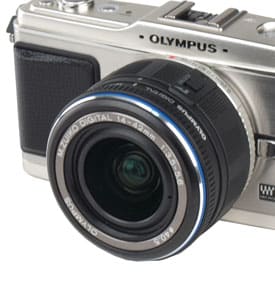
LCD
{{section_header}}{{section.name}}{{/section_header}}
The LCD on the GS-TD1 comes with a twist. Not only does it have a 3.5-inch touchscreen, but it also has a "glasses-free" 3D view mode. Yes, you can watch 3D video right on the camcorder itself, or you can switch to this mode and use it during 3D recording to better frame your shot. But hold on a second, does this 3D mode really enable you to see 3D images without the aid of special glasses? The truth is, not really. The mode produces a 3D effect on the LCD, but the images look blurry and will probably give you a headache if you look at it too long. And the resultant video will look entirely different on the LCD than it will on a big, 3D television that requires the use of 3D glasses. Basically, the LCD gives you a simplified, gimmicky 3D view mode that is in no way similar to the look of a 3D HDTV. In regular 2D view mode, the LCD looks pristine and beautiful. In fact, our favorite feature about the LCD's 3D mode is that you can turn it off and switch to regular 2D view whenever you want.
The GS-TD1 does not come with a viewfinder—not even for 2D-view only.
Connectivity
{{section_header}}{{section.name}}{{/section_header}}
JVC decided it was a good idea to scatter all the ports, terminals, and connectivity features over the large surface area of the GS-TD1. The most obvious ports are located inside the LCD cavity, which is where you'll find the SD memory card slot (works with SDHC and SDXC cards as well), the USB port, and the AV-out terminal. All are located behind flip-down tabs that feature icon labels so you know what port does what. Our only issue here is that these flip-down covers feel a bit loose (they don't really lock into place when closed). Also, the GS-TD1 does not have a Component-out terminal (AV and HDMI are the only video ports).
On the back of the TD1 are two more port collections: one, isolated port on the top of the camcorder, and another flip-down door that covers ports near the base of the unit. The ports at the bottom are the HDMI terminal and the DC-input, both of which are easy to access in their position. The port near the top is more hidden due to the camouflaged design of its cover. You'll see a small round bump that you can pull out to reveal the headphone jack (there's also a hard-to-see icon of a pair of headphones on the port cover). We'd like this port to be more obvious, and we're also not too happy that it is so far away from the external mic jack on the right side of the camcorder.
Like the headphone port, the mic jack on the TD1 is also hidden. It's on the right side of the camcorder, below the lens cover switch. The jack fits 3.5mm mic inputs and we like that JVC decided to cover it with a protector, but we don't like that it is so difficult to locate. In addition to the mic input, there's also an accessory shoe on the top of the camcorder where you can mount microphones, lights, etc. The shoe is not powered, though, so don't expect any accessory attached to be able to draw power from the TD1 when it is connected via the shoe.
Battery
{{section_header}}{{section.name}}{{/section_header}}
Setting the good battery life performance aside, we must admit we're not fans of the GS-TD1's battery compartment. The compartment is located on the right side of the camcorder, which means the door flips open in an area where the large hand strap can be in the way. You must insert the battery into a large, hollow compartment that is essentially the center of the camcorder. It's hard to get your fingers in there to make sure the battery has a proper fit, particularly if you don't have small hands. Let's just say this design is more difficult to access than a simple rear-mounted battery compartment like you see on most camcorders.

Media
{{section_header}}{{section.name}}{{/section_header}}
Loaded inside the GS-TD1 is 64GB of non-removable flash memory. While 64GB is quite a bit of internal flash memory, keep in mind that shooting 3D video at the highest quality setting takes up a lot of space. According to JVC, you can only store 4 hours of 3D video when using the THR record mode on the GS-TD1's 64GB of internal flash memory. In contrast, you can capture nearly 30 hours of regular HD video using the lowest-quality EP setting on the camcorder (2D video only).
So, even with the 64GB of internal memory, you're probably going to need to expand at some point by inserting memory cards into the GS-TD1. The camcorder's card slot works with all types of SD cards (including SDHC and SDXC cards). You'll want to use class 6 or higher cards, particularly when shooting with the higher-quality record modes. Read more about the advantages and disadvantages of various media types.

3D Lens
{{section_header}}{{section.name}}{{/section_header}}
Unlike the Panasonic HDC-SDT750, the first 3D camcorder we reviewed, the JVC GS-TD1's 3D lens system is not removable. You'll probably realize this the moment you hold the TD1 in your hands. Slapped on the front of the camcorder is a thick, dual lens system that both looks funny and makes the camcorder awkward to balance and heavier than your average consumer camcorder (the TD1 weighs a hefty 675g). The benefit to this built-in dual lens system is clear—you can capture 3D video at the click of a button, with little-to-no calibration required. The downside is that you are stuck with a bulky, 2-headed camcorder all the time, even when you're recording 2D video.
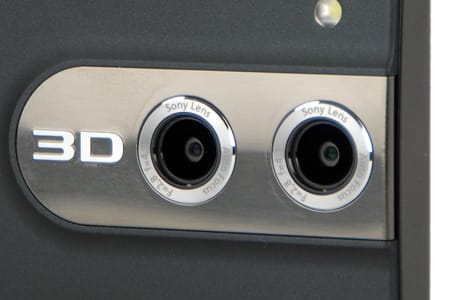
The second built-in lens is what lets you record video in 3D—without any tricky calibration.
The GS-TD1 offers manual parallax adjustment, but it is not required for shooting 3D. We found the camcorder did a good job when we used the auto parallax adjustment setting, which will attempt to adjust the parallax between the two lenses in order to create the optimal 3D effect. When you use the zoom during 3D recording, we noticed the GS-TD1 would automatically adjust the parallax along with the focus adjustment. This made it possible to produce a good 3D effect even when objects were very close to the camcorder. Yes, the focus and parallax adjustment took time to kick in, but this feature is certainly better than Panasonic's completely manual calibration system on the HDC-SDT750.
JVC recommends shooting 3D footage at a range of 1 to 10 meters (3.25 - 33 feet) when using no optical zoom. When using zoom, JVC says the 3D effect is best suited at a range of 5 to 50 meters (16 - 164 feet). You can shoot outside this range and the GS-TD1 will produce a 3D effect, but it may look awkward or take a while for the camcorder to adjust the parallax.
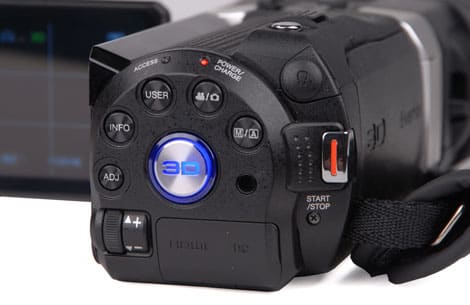
You can adjust a variety of controls—including zoom and focus—in 3D record mode.
3D Controls
{{section_header}}{{section.name}}{{/section_header}}
One of our favorite things about the GS-TD1 is that you can actually use manual controls in 3D mode. This is something that is not possible to do on the Panasonic HDC-SDT750, while the Sony HDR-TD10 allows for a limited amount of controls in 3D mode. If you want to be able to adjust things like aperture and shutter speed when recording 3D video, the JVC GS-TD1 is definitely your best option.
Unfortunately, the controls in 3D mode didn't always function very well when we adjusted them (particularly when we tried to make adjustments during recording). There was lag when we tried to make adjustments to every control other than manual focus. Changing shutter speed, exposure, white balance, and aperture all involved a very choppy interface that made it difficult to make precise adjustments. The camcorder even showed some severe signs of straining when we accessed the menu system during 3D recording. If you want to avoid this lag, you can make adjustments before recording begins, otherwise there isn't really away to get around this slow performance from the TD1.
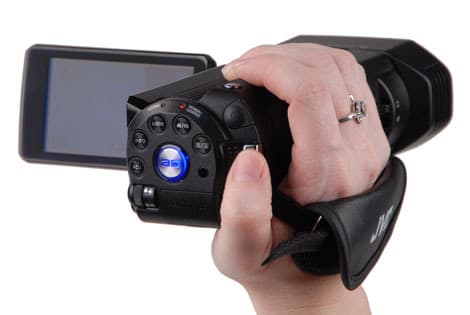
JVC lists plenty of warnings associated with 3D recording on the GS-TD1. It is not recommended to record or view 3D footage if you suffer from heart disease, feel sick or tired, haven't been sleeping much, or are drunk. Basically, don't take the TD1 on your late-night pub crawl (unless you're planning to shoot 2D footage only).
3D Playback
{{section_header}}{{section.name}}{{/section_header}}
We had some major frustrations with the 3D playback on the GS-TD1. Don't take this to mean we weren't able to view the 3D content on a 3D HDTV—that part we got down fine. What bugged us was the terrible quality of the "no-glasses" 3D LCD on the camcorder, and the annoying setup of the playback interface.
Just looking at the LCD in 3D mode gave us a headache. It offers a terrible, blurred image that does "look" like 3D, but doesn't offer a good 3D effect at all. It reminds us of those "3D" book covers that require you to tilt the book so you can see a slight hologram-like 3D effect. This is the kind of thing that might be cool for a few seconds, but it is not something you want to look at for an extended period of time. Thankfully, you can switch the LCD to a 2D view mode where the screen looks fantastic (but without a 3D effect).
The playback interface is equally annoying, and it may give you a headache as well. For starters, the VCR controls display front and center on the LCD screen during playback. They appear whenever you tap the screen and there is no option for making them immediately disappear—for that to happen, you must wait a few seconds for the VCR controls to automatically fade from the screen. Also, we noticed the controls working very sluggishly during 3D playback, particularly when we played back video shot with the highest-quality 3D modes.
Since the camcorder has a variety of shooting modes (2D, 3D AVCHD, 3D MPEG-4), finding the correct files in playback mode can be quite a chore. The playback screen only displays footage that corresponds to whatever mode the camcorder is in for recording. So, if you have the camcorder in 3D AVCHD mode, then switch to playback mode, only the 3D AVCHD files will display. No 2D video clips, no 3D MPEG-4 clips. This can make for a lot of switching back and forth between record mode and playback mode, especially if you like to record in a variety of different formats. We found it both confusing and extremely annoying. Why didn't JVC put an option to switch between these modes right in the playback menu? That would make it a whole lot easier to a) actually find what clips you're looking for and b) figure out the whole messy playback system.
Still Features
{{section_header}}{{section.name}}{{/section_header}}
The GS-TD1 can't capture still images at ultra-high resolutions like you see from most digital cameras these days. It tops out with a 2.9-megapixel still image option, which isn't terrible, but it is probably akin to the resolution of photos taken with your cell phone. To make up for this fact, the camcorder is loaded with lots of extra still image features like a 3D photo mode, multiple continuous shooting modes, a self-timer, and a smile shot option that automatically snaps a photo when your subject smiles. This is a good set of options, and the 3D photo setting is something that is not found on the Panasonic 3D camcorder.
Other Features
{{section_header}}{{section.name}}{{/section_header}}
3D Time Lapse Record
JVC has offered time-lapse recording on man camcorders in the past, but the GS-TD1 throws 3D video into the mix. Time-lapse recording is simple: you set an interval for the camcorder to record a few frames of video, and then you just leave the camcorder still for a long period of time. It is designed for capturing very slow processes like a flower blooming or a building being constructed. Now you can record these things in time-lapse 3D!
Canon Vixia HF G10 Comparison
Besides than the GS-TD1, the Panasonic HDC-SDT750 is the only other 3D camcorder we've reviewed so far. In short, we found the TD1 to be the far superior camcorder for recording 3D video, but the HDC-SDT750 is the more flexible model that's better for doing a mixture of 2D and 3D recording.

The two camcorders handle 3D recording in an entirely different manner. Instead of having two built-in lenses, the SDT750 has a removable lens converter that enables you to record 3D video (the converter is called the VW-CLT1). This converter also works with the new Panasonic HDC-TM900 and a few other new Panasonic models for 2011. The SDT750, however, is the only camcorder that actually comes with the converter—for the rest, you must purchase it separately.
Using the lens converter, the HDC-SDT750 splits one HD image into two side-by-side images in order to create a 3D effect. This is essentially what the GS-TD1 does with its lower-quality AVCHD 3D record modes. The HDC-SDT750 does not have a 3D mode that records two simultaneous Full HD images like the JVC GS-TD1 does.
By using the conversion lens system, the SDT750 can be turned into a more compact camcorder when you record 2D video (because the lens comes off). This is the advantage of using a conversion lens instead of a built-in 2-lens system like JVC uses on the GS-TD1. The conversion lens system also makes things more difficult in other ways. The lens must be calibrated when it is connected to the camcorder, it has an awkward connection system, and it does not allow for the same video quality in 3D mode as the dual-lens/dual-sensor system you see on the TD1.
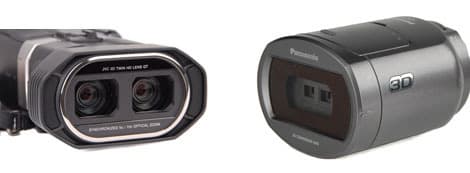
And that's where we really saw a stronger performance from the GS-TD1 over the HDC-SDT750. JVC's "Double Full HD" 3D record mode produced a sharper image with more clarity and detail than we saw from any of the SDT750's 3D video clips. The 3D effect on the TD1 wasn't all that better than what we saw from the Panasonic, however, but its video was sharper. When using the lower-quality AVCHD 3D record mode on the GS-TD1, we saw results that looked very similar to the Panasonic HDC-SDT750.
The Panasonic HDC-SDT750 offers little in the way of manual controls in 3D mode, and that's an area where the GS-TD1 takes the cake. This isn't to say the TD1 is a top-notch manual control camcorder for 3D recording. There were plenty of bugs, sluggish performance, and bad designs on the TD1 that made its manual controls very frustrating to use, but at least JVC offers them on the camcorder. The SDT750 doesn't even allow for zooming when you are in 3D record mode (the GS-TD1 has a 5x optical zoom when shooting 3D). The fact that you can zoom on the TD1 makes it possible to record a much wider range of 3D footage because it doesn't limit you to recording in the 4 - 10 foot range that the HDC-SDT750 requires.

As a 2D camcorder, the SDT750 is definitely the better product. Removing the lens converter and you have a wonderful, fairly compact, high-end HD camcorder with lots of controls and record modes. Switching to 3D mode and the JVC GS-TD1 becomes the much stronger candidate. It offers manual controls in 3D mode, more recording options, better performance, and easier use (no calibration required). If you're only shooting 3D, then get the GS-TD1. If you want to shoot both 3D and 2D, then the Panasonic HDC-SDT750 is the way to go.
JVC GZ-HM1 Comparison
Right off the bat, we should be clear: the Canon Vixia HF G10 does not record 3D video. It is a 2D camcorder through and through, and a very good one at that. The HF G10 is, perhaps, the most "professional" consumer camcorder we've seen in a while, in that it has a ton of manual controls and excellent video performance to boot. If recording 3D video is your primary objective, then this comparison may be meaningless to you. If you are looking for a top-notch 2D camcorder, however, you should set your sights on the Canon HF G10.
Even though it doesn't record 3D, the HF G10 is similar in size and weight to the JVC GS-TD1. Because of its large lens and solid construction, the G10 is one of the heftiest consumer camcorders on the block. It still weighs a bit less than the GS-TD1, but neither of these camcorders are something that you could toss into your pocket. These are bulky products, and you have to take this into consideration before your purchase.
The Canon HF G10 is the best camcorder, in terms of video performance, that we've reviewed so far this year. If you can deal with its size and plethora of controls, the G10 is a rewarding camcorder that has almost everything you need to create professional-grade videos.
COMP 3
Even though it was released last year, the GZ-HM1 is still JVC's top-of-the-line 2D consumer camcorder. It costs around $500 less than the GS-TD1, and the main difference between the two models is, you guessed it, the lack of 3D recording on the HM1. If you compare 2D video performance on these two models you will see they are very similar in terms of color accuracy, noise, sharpness, and overall low light performance. We'd probably give the HM1 a slight edge overall in 2D mode, but the difference is not extreme.
The GZ-HM1 does have a few features, like sharpness control and zebra patterns, that do not appear on the GS-TD1. It also has a more compact design (obviously), better adjustment dial for manual controls, and a Laser Touch Strip in lieu of a touchscreen interface. We found the Laser Touch Strip good fro making certain sweeping adjustments and for scrolling long menus, but it became increasingly difficult to use for adjusting precise controls. It also didn't always respond with strong accuracy. The touchscreen on the GS-TD1 is a bit better as far as control is concerned, and the fact that the LCD was bumped up to 3.5 inches (from 2.7 inches on the HM1) is one of our favorite improvements JVC made for the TD1.
Just as we said about the other comparison models we pitted the GS-TD1 against, we feel the GZ-HM1 is the better camcorder if you're only planning to record 2D video. The HM1's performance in our video testing was as good or better than the TD1's 2D performance, and the HM1 costs a whole lot less. Since JVC has yet to announce a new flagship camcorder for 2011, we have to continue to label the GZ-HM1 as the company's top-of-the-line 2D model for now.
Conclusion
If you are in the market for a high-end 3D camcorder you only have three options at the moment: the JVC GS-TD1, the Sony HDR-TD10, and the Panasonic HDC-SDT750 (and other Panasonic models that can use the VW-CLT1 3D conversion lens). There are also a few ultracompact models that shoot 3D, as well as a number of digital cameras, but the three models mentioned above are the only high-end HD camcorders aimed at consumers that allow 3D recording. Of those three models, the GS-TD1 is the second 3D camcorder we've reviewed—we brought the Panasonic HDC-SDT750 into our labs late last year.
In short, we like the GS-TD1 a lot more than the Panasonic in terms of 3D recording capability. For starters, it has far more 3D features: four 3D record modes, plenty of manual controls, a 3D still image capability, and even a time lapse recording function that works in 3D. Not to mention, the TD1 can use a 5x zoom when shooting 3D and its twin lens system automatically calibrates the camcorder to get the best 3D effect possible (manual parallax adjustment is possible as well).
With all that praise, it may sound like the GS-TD1 is the ultimate 3D recording machine, but it's not. There are plenty of flaws, bugs, and frustrating issues that keep the TD1 from being a great 3D camcorder. Response time on the camcorder's menu system was awfully slow (particularly when we tried to adjust controls while recording 3D video), the playback interface is terribly confusing, and the "glasses-free" 3D LCD gave us a headache after more than 10 seconds of viewing. The 3D footage captured with the camcorder, while better than what we saw from the HDC-SDT750, still had problems with trailing and interference, and it was nearly unwatchable if you moved the camcorder around too fast during recording. Shooting the perfect 3D video clip requires precise camcorder movements, intricate staging, and proper lighting.
But we're still impressed with the GS-TD1. You can have plenty of fun shooting 3D clips and the TD1 makes it simple. No funky lens calibration is required, you can simply point the camcorder at your subject and shoot away in three dimensions. The TD1's higher-quality "Double Full HD" settings offered very sharp images in 3D, although the 3D effect was no better than the lower-quality AVCHD 3D modes.
The TD1's list price of $1699 is a tough pill to swallow. It's around $500 more than any number of high-end 2D camcorders, and it's close to $300 more expensive than the original price of the Panasonic HDC-SDT750. You are paying for the novelty of being able to record 3D video, though, and keep that in mind. The GS-TD1 is a very good 2D camcorder, but if 2D recording is your primary objective you shouldn't even think about buying the TD1. There are cheaper, and better, 2D camcorders out there, and none of them have the bulk or weight of the GS-TD1. You should only consider this camcorder if you want to create 3D content first and foremost, or if you have $1700 to blow on a cool new gadget.
Photo Gallery
{{photo_gallery "Front Photo", "Left Photo", "Left Open Photo", "Back Photo", "Right Photo", "Top Photo", "Bottom Photo", "Lens Photo", "Lens Photo 2", "3D Lens Photo", "Media Photo", "Easy Mode Photo", "Manual Controls Photo", "Zoom Photo", "Zoom Photo 2", "Ease of Use Photo", "Battery Photo", "LCD Photo 1", "LCD Photo 2", "EVF Photo 1", "EVF Photo 2", "Mic Photo", "Mic Photo 2", "Ports Photo 1", "Ports Photo 2", "Ports Photo 3", "Ports Photo 4", "Ports Photo 5", "Ports Photo 6", "Handling Photo 1", "Handling Photo 2", "Handling Photo 3", "Handling Photo 4", "Box Photo"}}
Meet the tester
Jeremy is the video expert of our imaging team and Reviewed.com's head of video production. Originally from Pennsylvania and upstate NY, he graduated from Bard college with a degree in film and electronic media. He has been living and working in New England since 2005.
Checking our work.
Our team is here to help you buy the best stuff and love what you own. Our writers, editors, and experts obsess over the products we cover to make sure you're confident and satisfied. Have a different opinion about something we recommend? Email us and we'll compare notes.
Shoot us an email